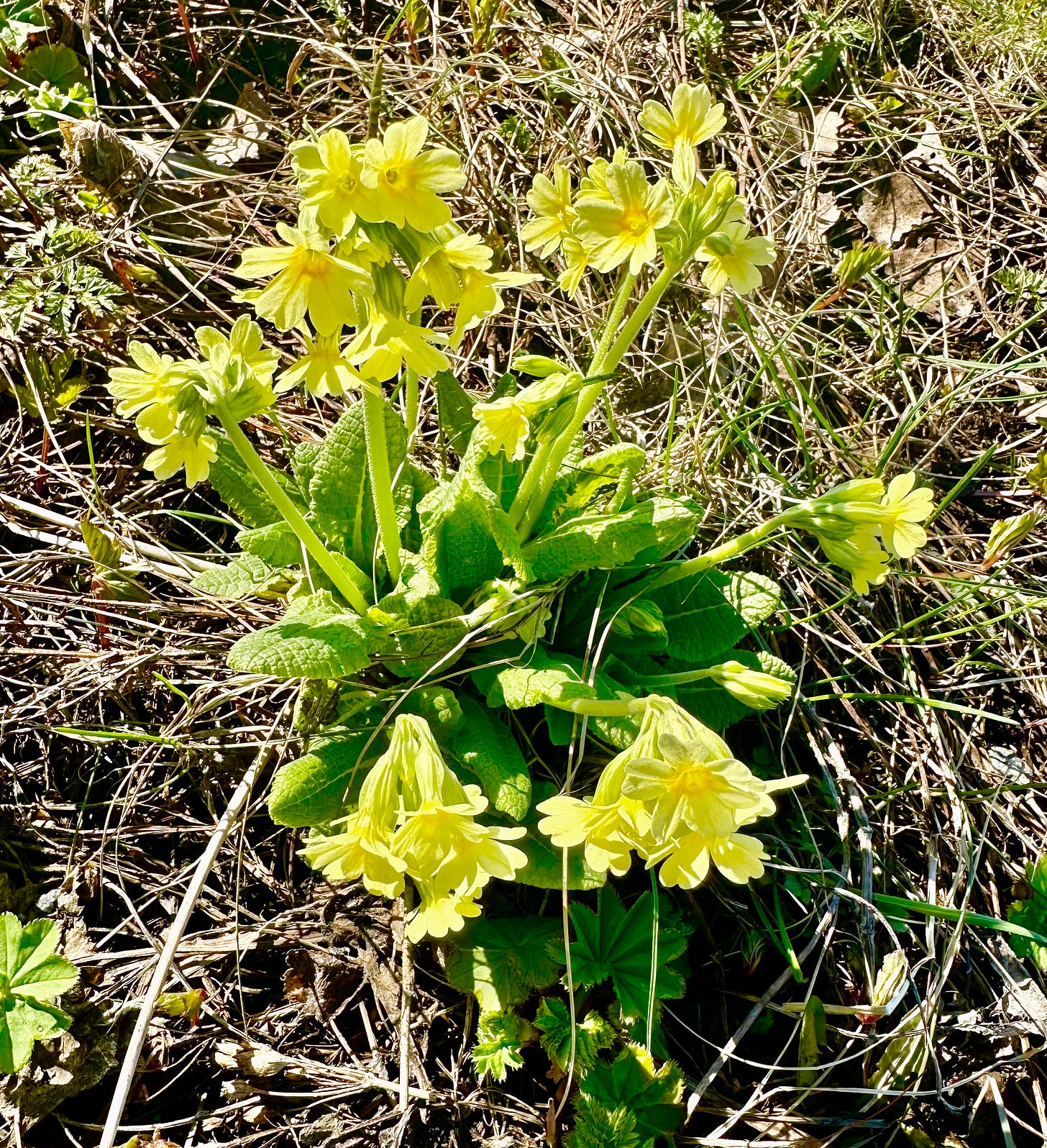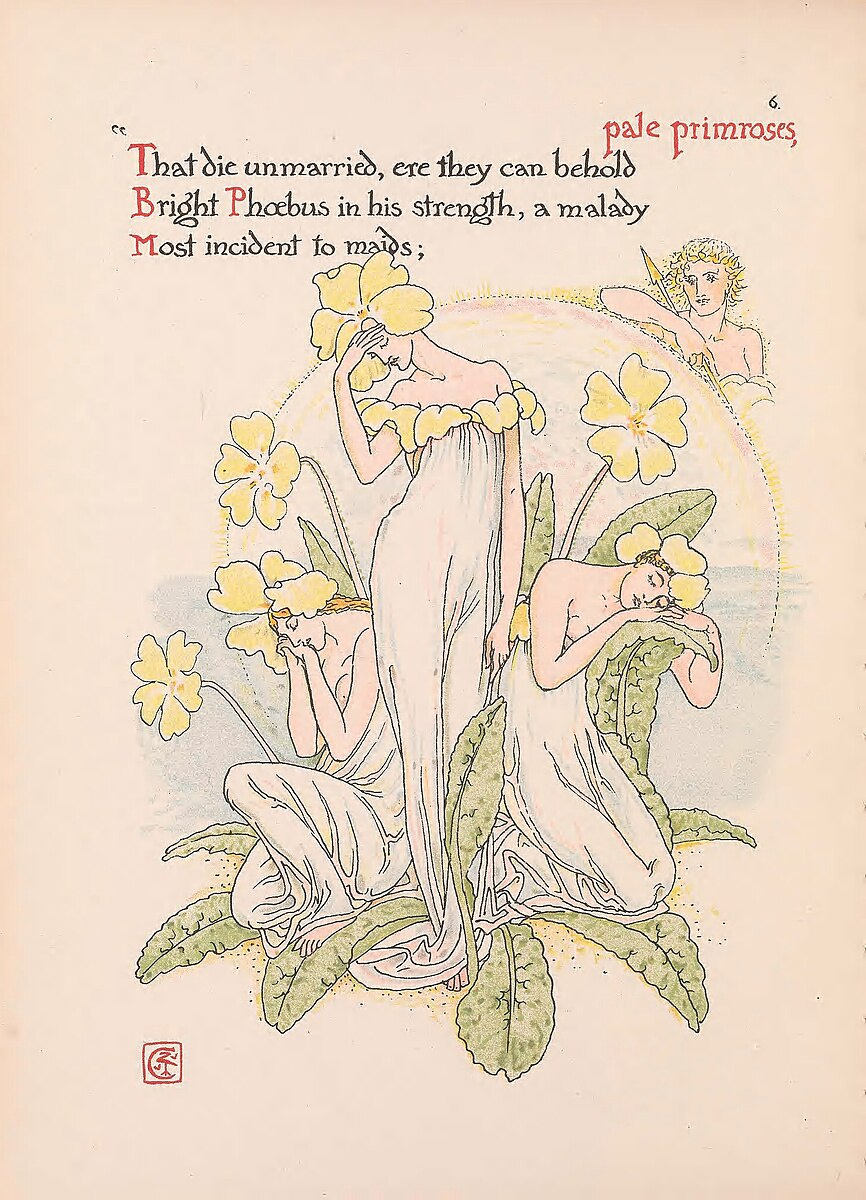Primrose: Freyja's Keys
On the medicinal and magical uses of Oxlip, Cowslip, and other Primula spp.
During the pandemic when I lived in western North Carolina and studied acupuncture and Chinese medicine, one of my favorite pastimes was to stroll around my neighborhood and discover what plants were growing, identify them, and then go home and research their medicinal and mystical uses in european herbalism and folklore. Then I would try and see if the plant (or a related species) was in used in Traditional Chinese Medicine to connect it to what I was learning in school.
While I had to memorize over three hundred herbs (which not only includes plants, but also minerals and some animal parts) and their medicinal uses for school, the only ones that have stayed in my memory a year later were the ones either I took medicinally for myself or the ones that I met in my neighborhood walks. The memorization that is required in most clinical herbal programs is an overview that gives the future herbalist an idea of what it is available, but studying herbal medicine will always feel stale and lifeless without cultivating a relationship with the plants, both as medicine and as living beings.
This is my first spring in Northern Norway and it is much different than western NC, which is temperate and has a gentle spring. Whereas in Tromsø, it snows seven to eight months out of the year and late spring is time of abrupt change — last week we had a blizzard and this week it is 16 degrees Celsius. In few days the sun will stop setting altogether, and we will be living with the Midnight Sun for two months. Now that the snow has melted, I plan like to continue my plant walks here and hope to share what I learn here on Substack.
Oxlip and Cowslip in European Herbalism
Walking to my acupuncture appointment this morning, I was delighted to see that several different types of wildflowers had appeared in the past week. However, a particular bell-shaped flower, which I saw growing along the road caught my eye more intensely. This flower looked exactly like the one I saw in my first shamanic journey three years ago, which to my frustration, I had never been able to identify. The only difference being that this flower was yellow instead of purple. I identified this yellow flowered plant as a species of Primrose (Primula elatior colloquially known as oxlip), but later this afternoon I learned that there does exist a purple species of this plant (Primula scandinavica) that only grows in Norway. I googled some pictures of it, and it looks like I finally found my mystery plant!

Oxlip is a Scandinavian and Eastern European wildflower, which also grows less abundantly in the United Kingdom (where it is threatened and shouldn’t be foraged). However, cowslip (Primula veris) is the more commonly used species in English and western european herbal traditions, and both are talked about almost interchangeably in western herbalism. Based on traditional use evidence (when there is documented widespread use of of plant for specific medicinal purposes in various cultures over enough time), Primula flowers are expectorants: they are used to treat wet coughs by helping to expel mucus. In terms of the flower’s constituents — or the biochemical properties which make it potentially pharmacological, there is research showing that two flowers contain different distributions of phenolic compounds despite the fact that oxlip and cowslip are used for similar medicinal purposes traditionally. Oxlip has more flavonoids compared to cowslip: rutoside (which may be able to reduce leg edema) and hyperoside which is potentially antimicrobial and anti-inflammatory.
Medicinal uses of Primula in Sowa Rigpa
There are several Primula species that grow at high altitudes in the Himalayas used in Sowa Rigpa or Traditional Tibetan medicine. However, it seems these species have similar medicinal uses as their european relatives. Primula denticulata or Drumstick Primula, is used for upper respiratory tract infections and indigestion and Primula rosea is used to treat muscle pain.

Lady’s Keys: primrose’s mystical & psychospiritual uses
Hildegard of Bingen, a medieval German catholic nun famous for her mystic visions, which included many insights into the medicinal use of plants, claimed that in addition to coughs, Cowslip contained the forces of the sun and was useful in treating melancholy. As such, she called it “Heaven’s Key.” This reminds me of Saint John’s Wort, which is also linked astro-herbally to the Sun and used to treat depression. In Christianity, Primrose is associated with Saint Peter, who is said to guard the gate to heaven.
However, the famous seventeenth century english physician-astro-herbalist Nicholas Culpeper connected cowslip with Venus:
“Venus lays claim to the herb as her own, and it is under the sign Aries; and our city dames know well enough the ointment or distilled water of it adds beauty, or at least restores it when it is lost.” - Nicholas Culpeper
Primrose has roots to Norse and Celtic folklore. The pale yellow flower is associated with the Norse God Freyja, and it’s symbol as a key in Christian Europe is most likely a Christianization of a pagan myth: it was known as “The Lady’s Keys” in Norse mythology, because it was thought to be able to magically transport someone across the threshold to Sessrúmnir, the goddess Freyja’s hall. Freyja is a Norse goddess associated with love, fertility, and war.
In celtic folklore, Primrose it is associated with crossing into the land of Faerie and was used as a protective flower to ward of evil spirits. It is also mentioned several times across a few of Shakespeare’s plays in reference to the Fairy Queen Titania.
Over hill, over dale,
Thorough bush, thorough brier,
Over park, over pale,
Thorough flood, thorough fire!
I do wander everywhere,
Swifter than the moon's sphere;
And I serve the Fairy Queen,
To dew her orbs upon the green;
The cowslips tall her pensioners be;
In their gold coats spots you see;
Those be rubies, fairy favours;
In those freckles live their savours;
I must go seek some dewdrops here,
And hang a pearl in every cowslip's ear.
Shakespeare, A Fairy’s Song
Whether or not one is inclined to believe in magical realms, it is interesting that Primula spp. are connected with spiritual thresholds, because they tend to grow on physical thresholds — on the edges of roads, rivers, or in woodland clearings. They also appear on the threshold between Winter and Spring (the name primrose comes from the latin “prima” meaning early rose).
The purple primrose that I saw during my shamanic journey three years ago was the only sign of life (besides a Tiger) popping out of a barren, snowy landscape in an underworld. The journey as a whole seemed to communicate mytho-poetically that something was coming — emerging out of several forgotten old traditions springing to life and communicating with one another to form something new. The only part that confused me was what this little flower had to do with it all. For now, I think I will start to explore that by gathering some flowers, drying them in the Midnight Sun, and making some tea.






Beautiful Christina! Love this glimpse of the journeys overlapping and across traditions.